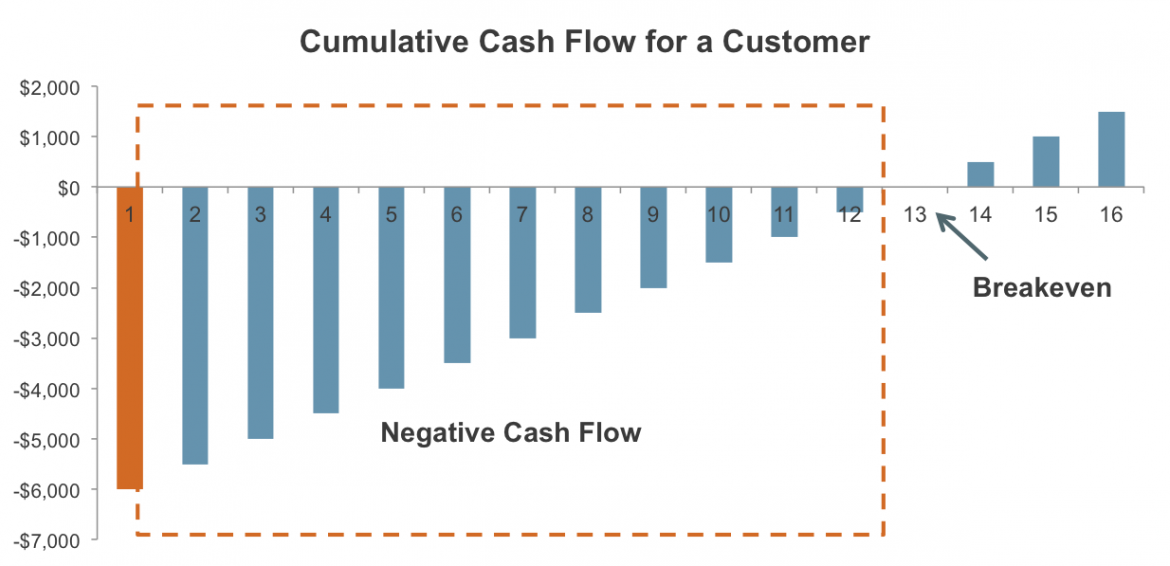
Marc Scott Kupor and Preethi Kasireddy of Andreesen Horowitz have delivered a thorough breakdown of why the pundits are wrong on Software as a Service (SaaS) valuations. They clearly identify how revenue recognition and cash flow for SaaS companies are grossly different than the traditional software business. As a PDO that has launched more than 50 products on the AppExchange, we are often assisting ISVs bringing SaaS products to market for the first time. There is an incredible amount of challenges in learning how to product manage, develop, build product roadmaps, push updates, support, market, and sell a SaaS product for the first time. What can quickly get lost in the mass of learning and the sprints to get an minimal viable product (MVP) to market is how to gauge the health of the business. The article lists out three primary metrics in determining the health of a SaaS business: Customer Acquisition Costs, Lifetime Value, and Churn.
Customer Acquisition Costs (CAC)
CAC is simply measured by the sum of all marketing and sales for a quarter divided by the number of new customers during the same quarter. This is a rough estimate of the cost of acquiring each new customer.
Churn
Churn is one of the best proxies for customer satisfaction there is. It quickly tells you how long customers stay subscribed. There are two ways to measure it, both providing a different insight into customer satisfaction. The first is on total customer count (either on a monthly or yearly basis). Measuring churn on a customer count basis provides a ratio of customers who leave the service, regardless of price point. Industry best practices show that your yearly churn should be lower than 5%. Note: This is yearly and not monthly (5% monthly churn would essentially mean that you would churn 46% of your customers on a yearly basis – a horrible hurdle to overcome.) A different angle, however, is revenue churn – the percent of revenue lost due to churned customers as a percent of total recurring revenue. I find this extremely interesting as it may highlight churn at certain subscription levels: lower priced plans (or free) churning heavily that do not, in the end, materially affect revenue. The opposite could hold true: higher priced plans do not provide enough value to justify the cost, resulting in churn of then top priced plans (greatly affecting revenue).
Lifetime Value (LTV)
LTV of a customer is the culmination of CAC and Churn, essentially answering if the cost of acquiring customers is worth it. It is calculated by the following formula: (Annual Recurring Revenue [ARR] x Gross Margin) ÷ (% Churn + Discount Rate) It is generally accepted that if your LTV is 3 times your CAC, you have a healthy SaaS business. Discount is an interesting metric that essentially states that future profits are not worth as much in today’s money as present profits. Interest rate is often used as a proxy for Discount, although Excel jockeys will often point out that this is a very poor proxy (and greatly in favor of companies given the current low interest rates). For early stage companies, it is often incredibly difficult to measure CAC, let alone come up with a Discount Rate for future years! Due to this, I often look at Annual Customer Value as a proxy for LTV. Reducing the horizon to just 12 months allows you to drop Discount Rate. Let’s be honest – do early stage companies/products really have the ability to accurately forecast beyond 12 months? Thankfully, your ISV org from salesforce (many times it is the same as your APO/LMO), is a great tool for tracking all of these metrics. Maintaining your marketing and sales data in Salesforce (including sales comps and revenue schedules) will provide you with all of the raw data to generate great SaaS dashboards.

